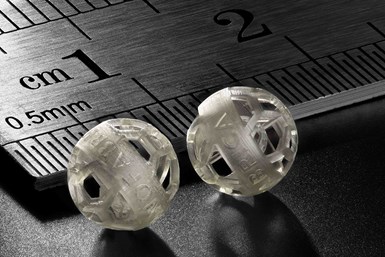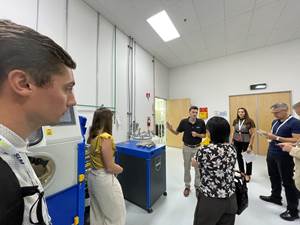Nano Dimension Broadens Range of Fabrica Micro-AM Printers
Formnext 2023: The key difference between the new Tera and Giga machines is essentially the build volume, with the smaller Giga machines designed for prototyping applications, while the larger Tera machines are aimed at higher volume production.
Share
Read Next
Nano Dimension’s additive manufacturing (AM) group has expanded its Fabrica Micro AM product line with a broader range of systems, including the Tera 25, Giga 250 and Giga 25, to offer new options for varying customer needs.
“Nano Dimension is responding to an exponential interest from industry, and our Fabrica range of Micro-AM solutions have been developed as compelling solutions for industries seeking precise and efficient micro manufacturing processes,” says Ziki Peled, president of Nano Dimension EMEA. “With the ability to create intricate structures and components on a micron scale, micro AM offers unparalleled design freedom and complexity, enabling the production of highly customized and optimized parts.”
The company says the micro technology minimizes material waste and reduces the need for assembly by fabricating complex geometries in a single build, leading to improved overall efficiency. “Industries such as electronics, medical devices, aerospace and automotive are finding immense value in Micro-AM, which is poised to play a pivotal role in driving innovation, cost-effectiveness and competitiveness across various sectors in today's rapidly evolving industrial landscape,” Peled adds. “Our suite of alternative micro AM solutions now allows us to meet the full range of strategic and application-specific customer requirements.”
The key difference between the Tera and Giga machines is essentially the build volume, with the smaller Giga machines aimed at prototyping applications, while the larger Tera machines are aimed at higher volume production. Both the Tera 250 and the Tera 25 have a build volume of 50 × 50 × 100 mm, while the Giga 250 has a build volume of 6 × 9 × 45 mm and the Giga 25 a build volume of 12 × 18 × 45 mm.
Both the Tera and Giga machines are capable of micron-level resolution. However, for companies looking to initiate prototype builds, the highly exacting resolution, tolerance attainment and surface roughness capabilities of the Tera series are not necessary. Unlike conventional prototyping, Micro-AM enables the direct creation of intricate and complex geometries without the constraints of subtractive manufacturing processes. This not only expedites the design iteration process but also enables the production of prototypes that accurately represent the final product's intended form and function.
“We have developed the Giga series of machines so our customers can cost-effectively benefit from micro-AM’s transformative approach to precision part and component prototyping, which surpass traditional methods in several crucial aspects,” Peled adds. “Micro-AMs high precision and fine resolution capabilities ensure the replication of intricate details and features, resulting in prototypes that closely mimic the end product’s characteristics. By embracing Micro-AM, industries can significantly accelerate innovation, reduce development lead times, and achieve a higher level of confidence in the functionality and performance of their prototypes.”
The Giga 25 and Tera 25 machines exhibit optical resolution of 8 microns, tolerance accuracy of 5 microns and achieve 0.9 micron surface roughness (Ra). The Giga 250 and Tera 250 exhibit optical resolution of 2 microns, tolerance accuracy of 2 microns, and achieve 0.4 micro surface roughness (Ra).
The range of build volumes, optical resolution, tolerance and surface roughness capabilities offered through the Giga and Tera machines are designed to fulfill a full range of customer prototyping and production requirements.
“Our mission is to democratize the use of Micro-AM in all industry sectors and application areas that can benefit from the use of 3D printing,” Peled says. “The economics and timeliness of Micro-AM as a prototyping technology are compelling. In the realm of production, Micro-AM's capacity to manufacture miniaturized yet functional components with remarkable precision is reshaping industries, from electronics to health care, by enhancing product performance, reducing assembly complexity and unlocking new realms of innovation.”
- Read about the Nano Dimension acquisition of Admatec and Formatec. With this acquistion, Nano Dimension says it is adding two critical aspects to its offering in the AM domain — materials and new product types.
- Learn how the Nano Dimension 3D printer complements micro moldmaking capabilities, providing a way for micro mold provider Accumold to produce microscale prototypes and rapid tooling.
Related Content
The AM Ecosystem, User Journeys and More from Formnext Forum Austin: AM Radio #43
Sessions and conversations at the first U.S. Formnext event highlighted the complete additive manufacturing ecosystem, sustainability, the importance of customer education, AM user journeys and much more.
Read MoreMeet The Cool Parts Showcase Winners
The Cool Parts Showcase winners for 2023 were announced at Formnext Forum Austin. Watch the award presentation here.
Read More8 Cool Parts From Formnext 2024: The Cool Parts Show #78
End-use parts found at Formnext this year address various aspects of additive's advance, notably AM winning on cost against established processes.
Read MoreTrinkle Additive App Suite Features Collection of Accessible, Intuitive Design Apps
Formnext 2024: The Additive App Suite builds on the success of the company’s fixturemate — a user-friendly design app for creating fixtures. The software includes three new apps with more to come.
Read MoreRead Next
Bike Manufacturer Uses Additive Manufacturing to Create Lighter, More Complex, Customized Parts
Titanium bike frame manufacturer Hanglun Technology mixes precision casting with 3D printing to create bikes that offer increased speed and reduced turbulence during long-distance rides, offering a smoother, faster and more efficient cycling experience.
Read MoreCrushable Lattices: The Lightweight Structures That Will Protect an Interplanetary Payload
NASA uses laser powder bed fusion plus chemical etching to create the lattice forms engineered to keep Mars rocks safe during a crash landing on Earth.
Read MoreProfilometry-Based Indentation Plastometry (PIP) as an Alternative to Standard Tensile Testing
UK-based Plastometrex offers a benchtop testing device utilizing PIP to quickly and easily analyze the yield strength, tensile strength and uniform elongation of samples and even printed parts. The solution is particularly useful for additive manufacturing.
Read More





















